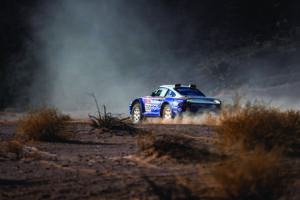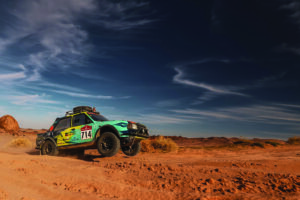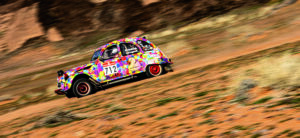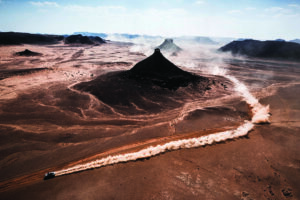Dakar Classic Saudi Arabia
HOME » Magazine » March 2024 » Rally News » Dakar Classic Saudi Arabia
Nearly 500 teams of bikes, trucks, buggies and cars, including 78 Classic entries, converged on a super-sized bivouac near the ancient Arabic oasis city of Al-’Ula (also known as AlUla) situated in the Hejaz region of Saudi Arabia on the historic incense route that once linked India and the Persian Gulf to the Levant and Europe and featured prominently in the history of Islam as well as several pre-Islamic Semitic civilizations.

Last year’s winners Lidia Ruba and Juan Morera won the prologue stage in the René Metge tribute Porsche just two days after Metge passed away
They were there for the start of the 46th edition of the Dakar Rally on 5 January, the fifth to be run in Saudi Arabia and the fourth Dakar Classic for historic vehicles. In total, 770 competitors were under starters’ orders. The classics were from the 1980s and 1990s including replicas of the Porsche 911s of René Metge and Jacky Ickx, Ari Vatanen’s 205 Peugeot and Jan De Rooy’s double-cab DAF truck.

Czech motorcylce racer Ondřej Klymčiw, and Josef Broz, in a Škoda 130LR were in the running to give Škoda its first Dakar Classic win, but electrical problems stymieid them on day 8
The two crews of the Porsche 959 tribute cars could not have dreamed of a better start, with a win on the prologue. Number 700, driven by last year’s winning couple of Lidia Ruba and Juan Morera in the René Metge replica, and number 759 manned by rookie Frederic Larre, and Jérémy Athimon, the mechanic responsible for building the two cars, repeated the Stuttgart marque’s historical 1986 one-two, making the curtain raiser a fine homage only two days after René Metge passed away.

There were fifteen trucks at the start of the race and the Italian team of Motortecnica was leading the category in 12th place at the end of stage 9. Driven by Corrado Pattono. who has been competing on the Dakar for two decades now, the Italian’s behemoth MAN 18-985 eventually finished second in the category behind the team led by Rafael Lesmes Suarez
But with more than 4,700 kilometres of special stages over two weeks of racing, it is always hard to know who will come out on top until the last stage is run.

Barbora Holická and Lucie Engová decided to modify and strengthen a Citroën 2CV and run it in the Dakar. The pair asked famous Czech artist Josef Rataj to paint it. The result was “Duckar”, a combination of “Dakar” and the word “duck”, as 2CVs are affectionately known in Prague. The two Czech friends managed to tackle the whole course and make it to the finish in their unlikely mount
Read the full story in the March 2024 Issue of Historic Motor Racing News – also available as a digital edition…


Camels during the Stage 4 of the Dakar 2024 on January 9, 2024 between Al Salamiya and Al-Hofuf, Saudi Arabia
These stories are all from the pages of Historic Motor Racing News. Some have been abbreviated for this web site. If you'd like to receive the full version, please visit our subscription page where you will find postal subscriptions available. A full subscription also entitles you to access the current issue online (available soon), so you can take it with you and read it anywhere, and we are working on providing full access to our archives of back issues exclusively for our subscribers.